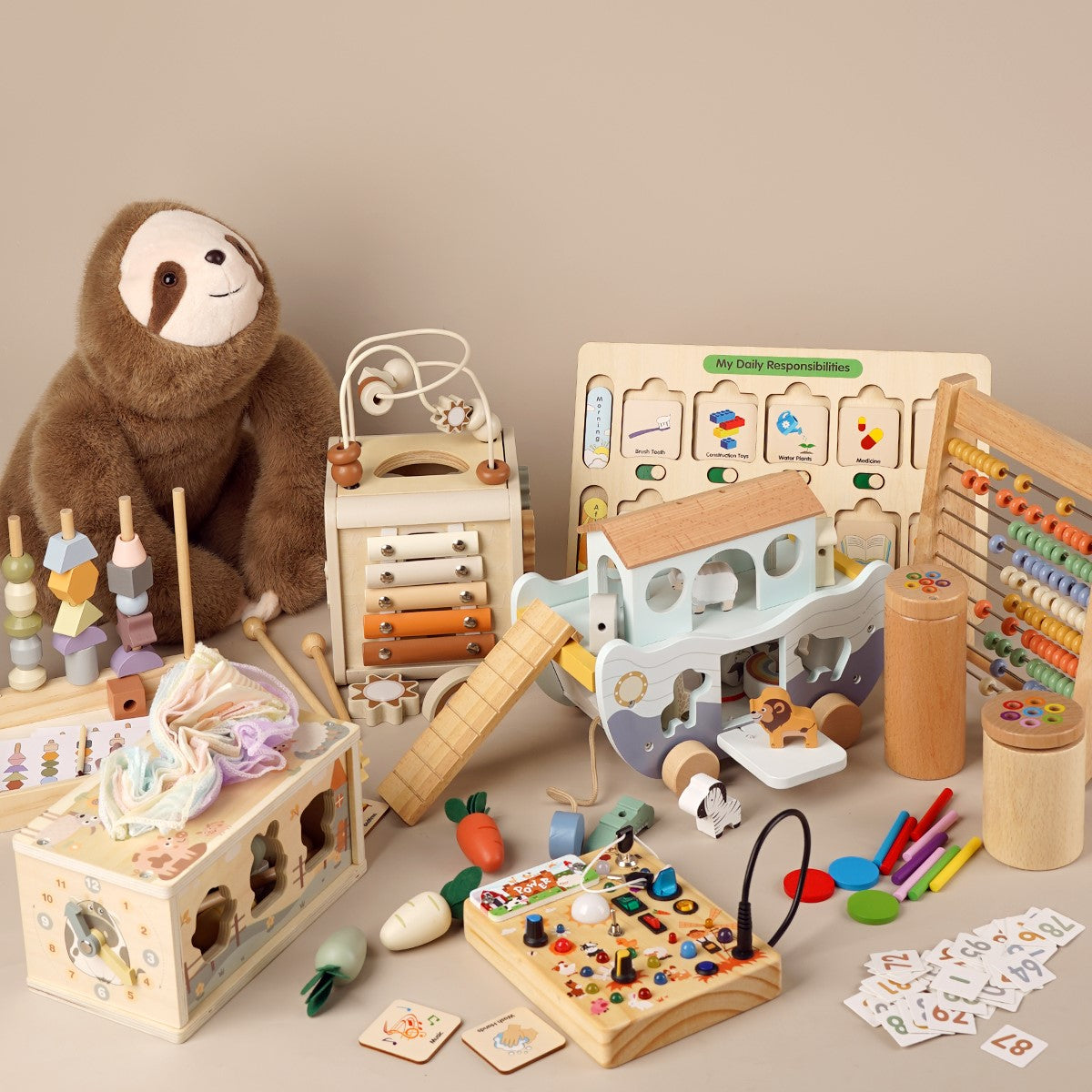What Makes a Montessori Toy “Montessori”? The Essential Guide for Parents
In recent years, “Montessori” has become a buzzword in the toy industry. From wooden puzzles to busy boards, countless products now carry the Montessori label. But here’s the truth: not every toy sold as Montessori actually follows Montessori principles.
So, what really makes a Montessori toy “Montessori”? Let’s dive into the philosophy behind these toys and how parents can make informed choices.
The Core Principles of a Montessori Toy
Montessori education, founded by Dr. Maria Montessori, emphasizes independence, hands-on learning, and natural curiosity. A Montessori toy should reflect these four core principles:
1. Self-Correcting Design
A Montessori toy helps children recognize and correct mistakes independently—for example, a puzzle piece that fits only one way or a shape sorter that builds spatial awareness. This encourages problem-solving and confidence.
2. Made from Natural Materials
Wood, fabric, and metal are preferred because they provide real sensory feedback, connect children to the natural world, and are more sustainable. Plastic or electronic toys usually don’t align with Montessori values.
3. Purposeful Play
Montessori toys mirror real-life skills such as pouring, buttoning, lacing, or stacking blocks. The goal is learning through hands-on exploration, not just entertainment.
4. Simplicity Over Overstimulation
Unlike flashy toys with lights and sounds, Montessori toys are simple and focused, helping children concentrate and engage deeply.
Common Misconceptions About Montessori Toys
“If it’s wooden, it must be Montessori.”
Not true. While many Montessori toys are wooden, some companies simply brand any wooden toy as Montessori—even if it lacks educational purpose.
“Montessori toys are only for Montessori schools.”
Wrong again. Parents can integrate Montessori toys at home. The key is to encourage independence and exploration.
“The more activities, the better.”
Actually, no. Busy toys overloaded with zippers, knobs, and buttons may look impressive, but they often distract rather than focus a child’s learning.
Examples of True Montessori Toys
Not every wooden toy marketed as Montessori fits the philosophy. Authentic Montessori toys are intentional, educational, and rooted in child development principles. Here are some classic examples:
- Object Permanence Box: Builds memory and problem-solving.
- Pink Tower & Knobbed Cylinders: Refine coordination, spatial awareness, and fine motor skills.
- Practical Life Sets: Miniature tools (brooms, pitchers, dressing frames) for real-world skills.
- Montessori Busy Board: Encourages independence and motor practice with zippers, locks, and switches.
- Montessori Music Toys: Simple instruments (xylophones, drums, shakers) that promote rhythm, creativity, and sensory play.
- Each of these toys nurtures hands-on learning, focus, and independence—the essence of Montessori philosophy.

Montessori Busy Board: A Parent Favorite or Just Hype?
Montessori busy boards are one of the most popular “first Montessori toys” parents buy. These boards feature zippers, latches, switches, and locks, designed to help toddlers practice fine motor skills.
Why Parents Love Them
- Encourage independence through practical life activities.
- Keep kids entertained during travel or quiet playtime.
- Offer a variety of textures and movements for sensory learning.
The Downsides Parents Mention
- Some boards are too cluttered, overwhelming children rather than focusing their attention.
- Prices can be inflated, especially for larger boards marketed as “premium Montessori.”
- Many parents report that a DIY version—made with thrifted zippers, buttons, and latches—works just as well at a fraction of the cost.
Conclusion: Finding the Right Montessori Toy Balance
Montessori toys can be game-changers for learning, but they aren’t one-size-fits-all. From montessori wooden toys that emphasize durability and simplicity, to busy boards that build independence, and music toys that nurture creativity, parents should always weigh practicality, budget, and their child’s unique needs. Sometimes, the best Montessori toy isn’t the most expensive one—it’s the one your child actually enjoys and engages with every day.
Maybe it will be helpful for you:
Recent Post

From Letters to Language: Helping Nonverbal Kids Communicate with Joyreal AAC
Many parents notice something fascinating: “My child doesn’t talk b...

Buy Once, Play Longer with Joyreal Toys
“We’re tired of toys that only last a weekend.”“I want toys that gr...

Love Is Learning Together: Valentine’s Day Educational Toys by Joyreal
When we think of Valentine’s Day, our minds often drift to roses, c...

A New Year, A New Beginning: Joyreal Toys’ Wish for Every Child
A Heartfelt New Year Message from Joyreal Toys As we welcome 2026, ...

Can Montessori Wooden Toys Grow With Your Child From 1 to 4?
When Your One-Year-Old Plays for Two Minutes and Walks Away It’s a ...

Mini Piano or Drum Set — Which Is Best for Kids?
As parents, we all face the same struggle — our children spend hour...

Is Phonics-Based AAC Right for Your Nonverbal Child?
Why Nonverbal Children Need AAC Devices For many parents, finding a...

Picture-Based AAC or Phonics AAC? A Parent’s Guide
Phonics vs Picture-Based AAC: Which Communication Tool Is Right for...

How Does Music Enlightenment Work for Ages 0–3?
Why Age-Specific Music Enlightenment Matters (0–3 Years) The first...

What Age Is a Noah’s Ark Toy For?
Is a Noah’s Ark Toy Good for Toddlers (Ages 1, 2 & 3)? When par...











